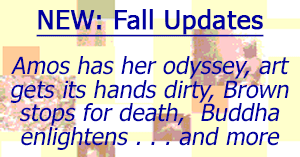Once again, allow me to use a holiday week to catch up with some posts that never made it to the blog. It has been a busy fall.Tracey Rose loves a pose. Her work at the Queens Museum takes no end of pleasure in putting on a show, but the actors and their roles are not so easy to pin down.
Women put on makeup and snarl for the camera—one, a title explains, on behalf of the KKK. Others dress up a bit much for propriety or not at all. The camera may close in a standing figure or step back, to reveal a stage set or forest landscape as welcoming and puzzling as they. Just do not expect this notably political artist to score much in the way of political points, through September 10.
Rose plays her part in a costume drama that is itself hard to pin down. One may not even guess correctly where it begins or ends. She gets the central open area for an enclosure that might be left over from Xaviera Simmons the season before, give or take a fresh, seriously bright paint job. She shines brighter still on surrounding walls. So which belong to Ciao Bella, which sounds like a love song, and which to Lucie’s Fur, which puns on Lucifer? No matter, with so content an all-woman cast.
Naturally the woman from the KKK, in whiteface but with a black eye or two and badly smeared black on her lips, belongs to neither one. Naturally, too, one cannot exactly enter the enclosure for a place to call home. Could that leave one in the forest, along with a woman on horseback with a preposterous top hat and another woman gesturing toward nothing that one can see? Could either be Lucie, which also puns on Lucy, the prototypical human being? One dare not call them primitive or in need of fur. They generate their own warmth, for those willing to play along.
One of two side galleries has room for work from twenty-five years, enough for a midcareer retrospective. Rose calls it “Shooting Down Babylon,” a bit odd, perhaps, for a show that cultivates voices. There the South African artist turns down the poses just a notch and admits men. There, too, the story coheres even less, except when it is too obvious for words. The white train of a bridal dress stands tall, but for what ceremony? A loose knit in the colors of the African National Coalition covers what might be black tomato with text that she alone can read.
In the show’s earliest photo, a man in performance etches his words into the wall of an arts institution that long barred blacks. Here the text is more cryptic still, and he might be sentenced to write it out like a schoolchild in need of a lesson. But then a biracial couple enacts The Kiss, after the sculpture by Auguste Rodin. There the lesson is clear—all the more so because the couple departs from Rodin’s pose to become intimate but relaxed. Is Rose too politically correct or not nearly enough for a modicum of coherence? Either way, these could be fragments of a story waiting for her to find an ending.
Either way, too, this is one politically correct museum, which has its uses. It devotes its other gallery to Aliza Nisenbaum, who has had a residency at the museum and a commitment to teaching art to the Mexican American community in Corona. Indeed, the show’s hanging and bright colors can suggest a schoolroom. (It adapts its title, “Queens, Lindo y Querido,” from a pop song in which the beautiful and beloved is Mexico, not Queens.) It also depicts members of the community, including workers at a food pantry and LaGuardia airport—a taxi driver and security guard included, along with pilots and flight attendants. A couple shares the Sunday New York Times.
The large paintings run to a loose perspective that enhances its diversity and color. Like poses for Rose, that has its pleasures. Both are well-intentioned, and their intentions can still get in the way. Rose speaks of her art as about the body, performativity, post-colonialism, healing, and rituality. Have I left anything out, and has she? Maybe it would work better as a photograph.
Read more, now in a feature-length article on this site.
